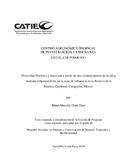| dc.contributor.advisor | Finegan, B. | |
| dc.contributor.author | Chan Dzul, Albert M. | |
| dc.contributor.other | CATIE - Centro Agronómico Tropical de Investigación y Enseñanza | |
| dc.date.accessioned | 2014-10-20T04:40:29Z | |
| dc.date.available | 2014-10-20T04:40:29Z | |
| dc.date.issued | 2010 | es_ES |
| dc.identifier | 374659 | es_ES |
| dc.identifier.uri | https://repositorio.catie.ac.cr/handle/11554/4812 | |
| dc.description | Tesis (Mag.Sc.) - CATIE, Turrialba (Costa Rica), 2010 | es_ES |
| dc.description.abstract | El presente trabajo busca contribuir con el conocimiento acerca del proceso de sucesión en una cronosecuencia de la selva mediana subperennifolia perturbada por la agricultura de RTQ en el área agrícola del ejido Nuevo Conhuás en la zona de influencia de la Reserva de la Biosfera Calakmul, a través de: i) determinar el avance del proceso de recuperación del bosque en términos de estructura, composición, riqueza y diversidad taxonómica ii) identificar tipos funcionales de plantas (TFPs) con base en rasgos respuesta a la perturbación por el sistema agrícola de RTQ iii) determinar y comparar la composición de los TFPs en términos de abundancia y área basal a través de la cronosecuencia y iv) determinar y comparar la diversidad funcional a través de la cronosecuencia con base en los rasgos respuesta al factor de perturbación por la RTQ. En 16 parcelas distribuidas a través de la cronosecuencia (4 parcelas de muestreo por categoría de edad: 4-6 años, 14-16 años, 19-21 años y BP) se muestrearon todos los individuos con dap mayor o igual que 5 cm. A las especies registradas se les determinó, combinando datos de campo y bibliográficos, cuatro rasgos funcionales para determinar los TFPs y la diversidad funcional: densidad de madera, altura máxima, fenología foliar y agente dispersor. En total se encontraron 113 especies arbóreas con una alta dominancia de la familia Fabaceae tanto en los bosques sucesionales como en el bosque primario (BP). | es_ES |
| dc.description.abstract | The following investigation pretends to contribute with the succession process knowledge using a sequence of the tropical semi evergreen forest disturbed by the shifting cultivation system agriculture in the commons of Nuevo Conhuas in the influence zone of the Biosphere Reserve of Calakmul, through: i) determine the forest recuperation process progress in terms of structure, composition, riches and taxonomic diversity, ii) Identify different plants functional types (PFT) based on the characteristics and the response to the disturbance caused by the shifting cultivation system, iii) determine and compare the components of the (PFT) in terms of abundance and the basal area through the chronosequence, and iv) determine and compare the functional diversity based on the response to the disturbance caused by the shifting cultivation system. In sixteen plots distributed across the chronosequence (4 sample plots per age category 4-6 years, 14-16 years, 19-21 years and BP), all the individuals with a dbh minor or equal to 5 were sampled.The registered species were determined by combining field and biography information, four functional characteristics were used to determine the PFT`s and functional diversity: wood density, maximum height, leaf phenology and dispersal mode. In total 113 tree species were found all of them with a high influence of the Fabaceae family in both the succesional forests and the primary forest (PF). | en_US |
| dc.language.iso | es | es_ES |
| dc.publisher | CATIE, Turrialba (Costa Rica) | es_ES |
| dc.rights | info:eu-repo/semantics/openAccess | es_ES |
| dc.subject | BOSQUE TROPICALMÉXICO | |
| dc.subject | DIVERSIDAD BIOLÓGICA | |
| dc.subject | SUCESIÓN ECOLÓGICA | |
| dc.subject | COMPOSICIÓN BOTÁNICA | |
| dc.subject.other | Sede Central | |
| dc.title | Diversidad florística y funcional a través de una cronosecuencia de la selva mediana subperennifolia en la zona de influencia de la Reserva de la Biosfera Calakmul, Campeche, México | es_ES |
| dc.type | Tesis de maestría | es_ES |


